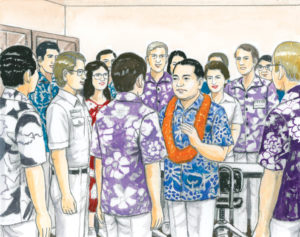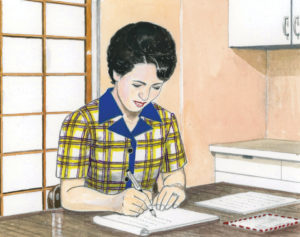Chapter Summary

Illustration courtesy of Seikyo Press.
On July 22, Shin’ichi Yamamoto flew to Honolulu to attend the 12th U.S. Nationwide General Meeting, the Blue Hawaii Convention and other related events. With the U.S. celebrating its bicentennial in 1976, this event had been designated as a pre-bicentennial celebration, and U.S. President Gerald Ford sent a congratulatory message.
The next day, on July 23, Shin’ichi participated in the opening of the convention’s control center, where he encouraged the staff. That evening, he invited visiting members from Argentina and Hiroshima, Japan, to his hotel for informal discussions. And the following day, he also welcomed representatives from Brazil and Peru to his lodging.
On July 26, the U.S. Nationwide General Meeting was held with the attendance of Hawaii Governor George Ariyoshi. Shin’ichi likened the Hawaiian “Aloha spirit,” which enables different ethnicities to peacefully coexist, to the Buddhist teaching of compassion and tolerance based on absolute respect for the dignity of life.
That night, a delegation of five people from Nicaragua joined the parade celebrating the general meeting. Among this delegation was a woman who had fulfilled her own promise to Sensei to bring four others with her to this convention.
The final evening of the event featured a musical that celebrated the history and spirit of the founding of the United States.
In between events, Shin’ichi met with dignitaries attending the convention. On July 29, he met members working behind the scenes, thanking them for their efforts. Fifteen years had passed since he had taken the first step for worldwide kosen-rufu in Hawaii. Now, a new current for peace was rising.
Unforgettable Scene

Illustration courtesy of Seikyo Press.
Inspired By a Heartfelt Letter
At a July 1975 parade in Hawaii, five members from Nicaragua, where a chapter had just been formed, received special applause. When Kiyoko Yamanishi, the chapter women’s leader, returned home to Nicaragua, she wrote Shin’ichi Yamamoto a letter of appreciation.
In response, Mineko Yamamoto composed a long letter on behalf of her busy husband. In it, she wrote: “I was happy to receive your letter. It was wonderful to see you looking so well in Hawaii. And given the difference in circumstances, bringing a contingent of five members from Nicaragua should be considered the equivalent of assembling five hundred from Japan. Recognizing that this was the first time that members from Nicaragua were participating in a Soka Gakkai parade, my husband and I applauded with tears in our eyes.”
Shin’ichi had asked Mineko to communicate his feelings in response to the letter that Mrs. Yamanishi had sent, so Mineko’s letter was from Shin’ichi as well. They had always worked together in this way for kosen-rufu. …
In her letter to Mrs. Yamanishi, Mineko continued: “Our organization in Nicaragua is now at the most critical and difficult stage, the stage of building the foundation. Please take your time and make it a strong one, working steadily and without rushing things. … We have the greatest respect and admiration for your diligent efforts as the linchpin of members’ unity.” …
Mineko went on to describe Shin’ichi’s struggles as well as the way that members in Japan regarded their activities: “As the economic downturn grows more severe, members are taking action with the conviction that it is the perfect opportunity to demonstrate the effectiveness of our practice, and they’re engaging in dialogue about Buddhism with even greater energy.”
Mineko closed by conveying her and Shin’ichi’s regards to Mrs. Yamanishi’s husband and all the members in Nicaragua, adding that they would pray for the health and prosperity of her family.
Mrs. Yamanishi read the letter with tears in her eyes. She felt that President Yamamoto and Mineko understood the circumstances faced by her and all the members in Nicaragua, and that Shin’ichi was thinking of them, even though they were far away. She was reassured that both he and Mineko were always looking after her and the members, and she determined to do her very best. …
Words from the heart have the power to inspire. (The New Human Revolution, vol. 22, pp. 172–73)
Key Passages
Upon reaching a deadlock, it is best to return to the starting point. For Nichiren Buddhists, this means chanting Nam-myoho-renge-kyo. Since the Mystic Law is the fundamental Law of the universe, prayers invoking the Mystic Law have the power to make anything happen. (NHR-22, 114)
■ ■ ■
The SGI spirit is for each individual to be a good citizen and the conscience of his or her community and country. It serves as a driving force for creating peace and prosperity of society and the happiness of all people. (NHR-22, 160)
You are reading {{ meterCount }} of {{ meterMax }} free premium articles

